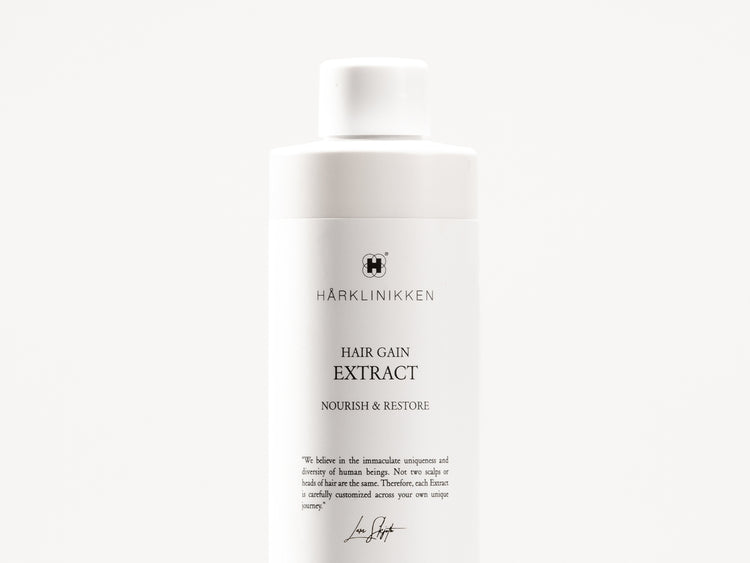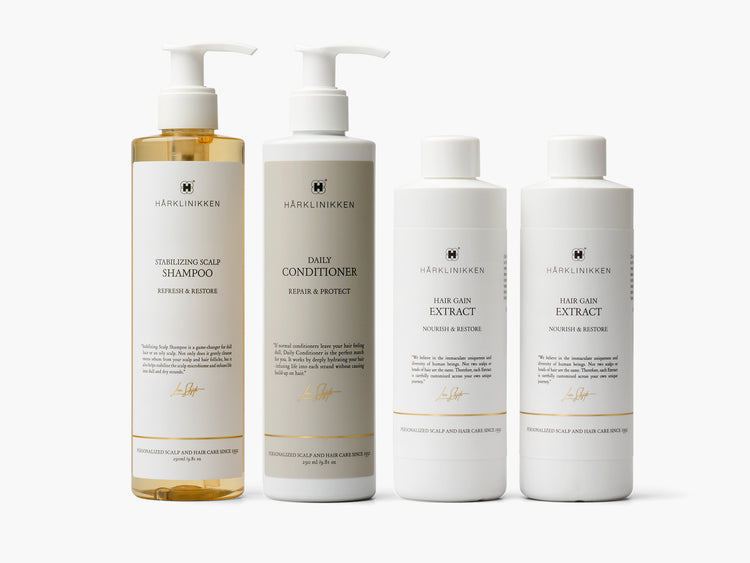A hormone that plays a key role in hair growth, DHT is also widely associated with hair loss – something that around 66% of men will experience by the time they reach 35 years old and one in three women will deal with at some point in their life. While not all hair thinning and loss is due to DHT, we're answering all your questions about the hormone and its effect on your scalp and strands.
What is DHT?
First things first: DHT is the abbreviation of dihydrotestosterone, a hormone that the body produces naturally. It occurs when testosterone – a hormone that all genders produce – is converted (or metabolised) by the 5-alpha reductase enzyme. This process happens in the liver, prostate (if you have one) and the skin.
How is DHT linked to hair loss?
Because the 5-alpha enzyme converts testosterone into DHT in the skin, that includes the scalp. Increased DHT activity has been linked to hair thinning and loss, and may play a role in follicles shrinking and shortening the hair growth cycle. These changes to the hair and follicles can lead to hair miniaturisation.
What is hair follicle miniaturisation?
A healthy hair follicle will have rich blood flow (meaning it gets all the nutrients and oxygen it needs) and a strong hair shaft firmly rooted in its base. But what occurs during hair follicle miniaturisation is that, over time, the follicle progressively shrinks. This means the follicle produces strands of hair that are thinner, weaker, more prone to breakage. Eventually this shrinkage means follicles can no longer produce hair that is visible to the eye.
Does DHT affect men and women?
While often linked to hair loss in men (often referred to as “male pattern balding”), DHT doesn’t discriminate when it comes to sex and gender. All bodies produce DHT – whether in testes, ovaries, adrenal glands, fat cells, or skin cells. Many women, especially those in perimenopause or menopause, experience DHT sensitivity and hormonal imbalances which have been associated with changes in hair texture and increased hair thinning.
At what age does DHT cause hair loss?
Typically, men begin producing more DHT in their mid-to-late 20s, while hormone level changes occur in women during perimenopause and menopause – sometimes leading to increased sensitivity to DHT. That said, because most people begin developing higher levels of DHT during puberty, it can occur much earlier.
What causes DHT to increase?
There are various contributing factors that result in elevated DHT levels or increased DHT sensitivity.
- Genetics
- Ageing
- Hormonal imbalances
- Diet
- Stress
Can hair loss from DHT grow back?
DHT is just one possible factor in hair thinning, so it’s important to gather as much knowledge about your scalp and hair profile as possible. Because hair follicle miniturisation is a process that occurs over a long period of time, there are steps you can take to combat it. The key is starting to properly care for your scalp and hair follicles as soon as possible. We recommend taking our Hair Assessment or booking an in-person consultation with a Hair Specialist to begin your personalised routine designed to create the best conditions stronger, healthier hair growth.
FAQs
Is blocking DHT good for combatting hair loss?
As with anything in your body, it’s ideal to have a healthy, “just right” amount – not too little, not too much. Therefore, people experiencing hair thinning associated with DHT may consider ways to reduce the impact through ingredients that are known to block DHT either through inhibiting the conversion of testosterone to DHT or through preventing DHT from binding to androgen receptors. As the name suggests, DHT blockers inhibit the body’s production of dihydrotestosterone. Some are naturally occurring, while others come in the form of medication or supplements.
Is saw palmetto a DHT blocker?
Saw palmetto – a palm that can grow up to 10 feet tall and boasts blue-black berries – has been widely linked to inhibiting the production of DHT. Additionally, it contains fatty acids, plant sterols and flavonoids that can help improve the quality of hair strands. But not all saw palmetto is created equally, and some supplements on the market incorporate poor quality saw palmetto combined in imprecise or inadequate formulations.
Does Hårklinikken include saw palmetto in the Hair Supplement?
We use only the highest grade of saw palmetto – developed with sophisticated science to create synergistic effects with other carefully selected ingredients – to optimise hair quality and scalp health. Overall, our Hair Supplement* is designed to target eight key contributors to hair loss, hair thinning and shedding. It addresses three biological triggers while supporting five factors essential to hair growth, health, strength and density.
*Hårklinikken has decided to launch the new Hair Supplement in the US first, with hopes to extend its availability to other markets in the future.

Unsure where to start?
We only accept candidates who we believe we can help, which is why our online Hair Assessment is the best place to start. Based on your results, you will either qualify for immediate treatment or we will organise a consultation.




